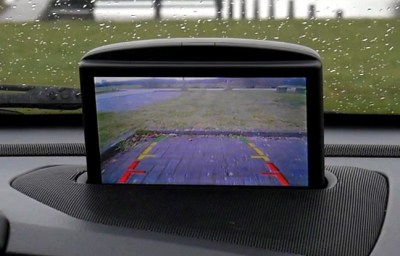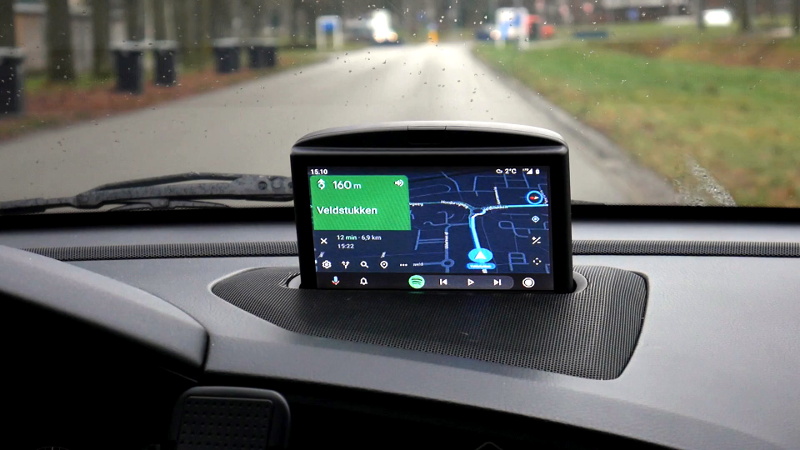As [Luuk Esselbrugge] explains in a recent blog post, his 2002 Volvo S60 had an optional GPS navigation system and backup camera that used a motorized display that would rise out of the dashboard when needed. His particular car didn’t come with the hardware installed, but after getting his hands on a display module and doing some research, he figured out how he could drive it with the Raspberry Pi and a couple of microcontrollers.
Given the age of the display, you probably won’t be surprised to hear that it uses composite video. Not exactly high resolution, but in the demonstration after the break, we have to admit it looks more than up to the task. [Luuk] is running Android Auto on the Raspberry Pi 3 through the openauto project, which gives him a nice big display and access to all the navigation and media applications you’d expect. The display doesn’t support touch, but thanks to an ESP32 plugged into the CAN bus, he’s able to control the software by reading the buttons built into the Volvo’s steering wheel.

To actually raise and lower the display, [Luuk] found you just need to fire a few bytes down the 1,200 baud serial bus that’s built into the display’s wiring harness. The ESP32 handles this duty as well, at least partly because it’s already plugged into the CAN bus and can tell when the vehicle is in reverse. This lets it bring up the screen to show the video feed from the newly installed backup camera in the event that the Pi hadn’t already asked to raise the display. Incidentally plugging in the phone normally triggers the system to wake up and raise the screen, and disconnecting it will command the screen to lower back into the stowed position.
The attentive reader or Volvo aficionado may be wondering how [Luuk] got the audio working. Since his car’s sound system doesn’t feature an auxiliary input, he’s using an Arduino to spoof the existence of a CD changer, which allows him to inject an audio signal into one of the pins on the back of the radio. Eventually he wants to move this task over to the ESP32, but he says a big change like that will have to wait until warmer weather.
This isn’t the first time we’ve seen the Raspberry Pi used to add enhanced features to a somewhat older vehicle. While some bemoan the increased complexity of modern vehicles, it seems some hackers can’t get enough of it.
















Now this is a hack. In fact this is many hacks combined. Great job.
I have a cheapass Ford, and always wanted to put a bigger screen on it that I could actually see instead of the phone-sized one. This encourages me.
Hmmmm might be worth pursuing that avenue for an unVolvo … Keep wanting to do something with an old tablet, rigidly mounted to vehicle, but don’t have a good solution for the crackhead problem… i.e. smashing $500 of glass and ripping it out to find out it’s NOT a top of the line iPad the pawnbroker will give them hundreds for like they imagined.
There’s always the fibreglass/bondo smoothing of the mounting mechanisms, so it looks like part of the dashboard, which will help with the ‘crackhead’ I would expect.
Though I don’t think there is any complete solution to that sort of issue.. Even the hiding it Volvo method won’t stop the arse from ripping out the cd player etc – always something worth trying for if you are desperate for that payout or enough of an arsehole… Perhaps you should just replace all the glass with Polycarb, nice and thick..
Put in an audio amplifier that runs from a high voltage battery. Then hope the thief is greedy (what thieves of that kind aren’t?) and gets fried trying to undo the live high voltage wires.
Replacing glass with polycarbonate windows is not legal in EU, car would not pass its annual inspection. Front window must be of laminated glass and side windows must be made of tempered glass so that in case of an accident they don’t cause harm to pedestrians or rescue services.
I have a project called open-dash where I built an esp32 based daughterboard that communicates to a linux machine, usually a small x86 or pi that fits in the dash. I use the esp32 to control low level signalling like j1850 and CAN and power on/off the main computer. The daughterboard has a nice 4 channel audio amp that I’ve used for many applications (arcade cabinets, home speakers, bathroom speakers, etc…). This worked amazingly well in my dodge promaster. But I have an 07′ corvette I want to control the hvac which would make for a very nice portiat looking ‘tesla’ style display. I just received the my board (mostly populated) from jlpcb with the hvac addition – which required lots more adc and gpio. I wrote drivers for those and things are looking good!
Software stackup is freertos (esp-idf) on esp32 -> node.js, nw.js on ubuntu
I have the circuit, code, and 3d model of the stereo housing on my github:
https://github.com/physiii/open-dash
I’m looking for a list of parts and programs that will make a raspberry pi 4 b connect to a 2006 audi quattro for live communication I have obtained a data cable and! Ross tec software with it Essa
The automotive hacking that is coming out on Hackaday is really exciting. Now I have a whole new hobby I didn’t need. I recently saw a similar story on hacking the Nissan display. I have a Nissan Rogue which is now going to be the subject of a hacking project.
More importantly though is my diesel tractor. Yes, tractor. It is in sorry need of an upgrade in electronics. I have a number of functions I want to add like a clock (yes it does not have a clock), a battery voltage display, a engine temperature and transmission temperature sensor, a camera to display the implement I am pulling (like my square baler), well you get the general idea.
So if anyone knows of an article for hacking a farm tractor please let me know.
It’s been on my list for a while now……Like all of us, we have more list items than we have time to work on them.
Glenn.
My car doesn’t have an RTI installed from the factory. When I I install the RTI screen, how do you make a harness to connect wires from an Arduino to the RTI? And how do you power the arruino and a raspberry pi 4, and where do you keep it in the dash?
Hi tom, ik zie dat je uit de regio emmen komt? Zou je eens contact willen opnemen hoe je dit hebt gerealiseerd?